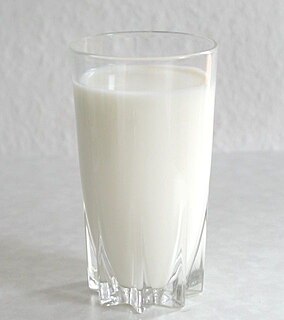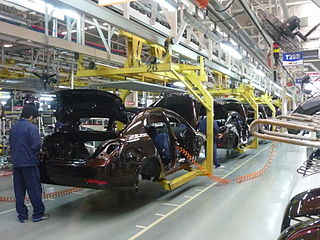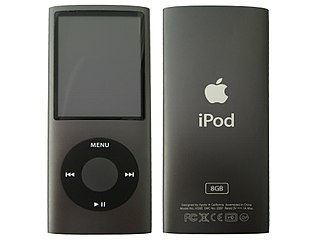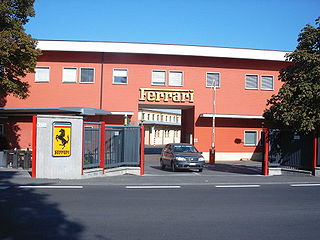
Advertising is a marketing communication that employs an openly sponsored, non-personal message to promote or sell a product, service or idea. Sponsors of advertising are typically businesses wishing to promote their products or services. Advertising is differentiated from public relations in that an advertiser pays for and has control over the message. It differs from personal selling in that the message is non-personal, i.e., not directed to a particular individual.
Advertising is communicated through various mass media, including traditional media such as newspapers, magazines, television, radio, outdoor advertising or direct mail; and new media such as search results, blogs, social media, websites or text messages. The actual presentation of the message in a medium is referred to as an advertisement, or "ad" or advert for short.

Dairy products, milk products or lacticinia are a type of food produced from or containing the milk of mammals, primarily cattle, water buffaloes, goats, sheep, camels, and humans. Dairy products include food items such as yogurt, cheese, and butter. A facility that produces dairy products is known as a dairy, or dairy factory. Dairy products are consumed worldwide, with the exception of much of East and Southeast Asia and also some parts of central Africa.
E-commerce is the activity of buying or selling of products on online services or over the Internet. Electronic commerce draws on technologies such as mobile commerce, electronic funds transfer, supply chain management, Internet marketing, online transaction processing, electronic data interchange (EDI), inventory management systems, and automated data collection systems.

Gross domestic product (GDP) is a monetary measure of the market value of all the final goods and services produced in a period of time, often annually.
GDP (nominal) per capita does not, however, reflect differences in the cost of living and the inflation rates of the countries; therefore using a basis of GDP per capita at purchasing power parity (PPP) is arguably more useful when comparing differences in living standards between nations.

In linear algebra, an inner product space is a vector space with an additional structure called an inner product. This additional structure associates each pair of vectors in the space with a scalar quantity known as the inner product of the vectors. Inner products allow the rigorous introduction of intuitive geometrical notions such as the length of a vector or the angle between two vectors. They also provide the means of defining orthogonality between vectors. Inner product spaces generalize Euclidean spaces to vector spaces of any dimension, and are studied in functional analysis. The first usage of the concept of a vector space with an inner product is due to Giuseppe Peano, in 1898.

Manufacturing is the production of products for use or sale using labour and machines, tools, chemical and biological processing, or formulation. The term may refer to a range of human activity, from handicraft to high tech, but is most commonly applied to industrial design, in which raw materials are transformed into finished goods on a large scale. Such finished goods may be sold to other manufacturers for the production of other, more complex products, such as aircraft, household appliances, furniture, sports equipment or automobiles, or sold to wholesalers, who in turn sell them to retailers, who then sell them to end users and consumers.
Marketing is the study and management of exchange relationships. Marketing is the business process of creating relationships with and satisfying customers. With its focus on the customer, marketing is one of the premier components of business management.

Amazon.com, Inc., is an American multinational technology company based in Seattle, Washington that focuses in e-commerce, cloud computing, and artificial intelligence.

In mathematics and vector algebra, the cross product or vector product is a binary operation on two vectors in three-dimensional space
and is denoted by the symbol
. Given two linearly independent vectors
and
, the cross product,
, is a vector that is perpendicular to both
and
and thus normal to the plane containing them. It has many applications in mathematics, physics, engineering, and computer programming. It should not be confused with the dot product.
In mathematics, the dot product or scalar product is an algebraic operation that takes two equal-length sequences of numbers and returns a single number. In Euclidean geometry, the dot product of the Cartesian coordinates of two vectors is widely used and often called "the" inner product of Euclidean space even though it is not the only inner product that can be defined on Euclidean space; see also inner product space.

Cosmetics are substances or products used to enhance or alter the appearance of the face or fragrance and texture of the body. Many cosmetics are designed for use of applying to the face, hair, and body. They are generally mixtures of chemical compounds; some being derived from natural sources, and some being synthetics or artificial. Cosmetics applied to the face to enhance its appearance are often called make-up or makeup. Common make-up items include: lipstick, mascara, eye shadow, foundation, blush, and contour. Whereas other common cosmetics can include skin cleansers, body lotions, shampoo and conditioner, hairstyling products, perfume and cologne.

Industrial design is a process of design applied to products that are to be manufactured through techniques of mass production. Its key characteristic is that design is separated from manufacture: the creative act of determining and defining a product's form and features takes place in advance of the physical act of making a product, which consists purely of repeated, often automated, replication. This distinguishes industrial design from craft-based design, where the form of the product is determined by the product's creator at the time of its creation.
Retail is the process of selling consumer goods or services to customers through multiple channels of distribution to earn a profit. Retailers satisfy demand identified through a supply chain. The term "retailer" is typically applied where a service provider fills the small orders of a large number of individuals, who are end-users, rather than large orders of a small number of wholesale, corporate or government clientele. Shopping generally refers to the act of buying products. Sometimes this is done to obtain final goods, including necessities such as food and clothing; sometimes it takes place as a recreational activity. Recreational shopping often involves window shopping and browsing: it does not always result in a purchase.
In business and engineering, new product development (NPD) covers the complete process of bringing a new product to market. A central aspect of NPD is product design, along with various business considerations. New product development is described broadly as the transformation of a market opportunity into a product available for sale. The product can be tangible or intangible, though sometimes services and other processes are distinguished from "products." NPD requires an understanding of customer needs and wants, the competitive environment, and the nature of the market.
Cost, time and quality are the main variables that drive customer needs. Aiming at these three variables, innovative companies develop continuous practices and strategies to better satisfy customer requirements and to increase their own market share by a regular development of new products. There are many uncertainties and challenges which companies must face throughout the process. The use of best practices and the elimination of barriers to communication are the main concerns for the management of the NPD.

A software release life cycle is the sum of the stages of development and maturity for a piece of computer software: ranging from its initial development to its eventual release, and including updated versions of the released version to help improve software or fix software bugs still present in the software.
In marketing, a product is a system made available for consumer use; it is anything that can be offered to a market to satisfy the desire or need of a customer. In retailing, products are often referred to as merchandise, and in manufacturing, products are bought as raw materials and then sold as finished goods. A service is also regarded to as a type of product.

PepsiCo, Inc. is an American multinational food, snack, and beverage corporation headquartered in Harrison, New York, in the hamlet of Purchase. PepsiCo has interests in the manufacturing, marketing, and distribution of grain-based snack foods, beverages, and other products. PepsiCo was formed in 1965 with the merger of the Pepsi-Cola Company and Frito-Lay, Inc. PepsiCo has since expanded from its namesake product Pepsi to a broader range of food and beverage brands, the largest of which included an acquisition of Tropicana Products in 1998 and the Quaker Oats Company in 2001, which added the Gatorade brand to its portfolio.

Cannabidiol (CBD) is a phytocannabinoid discovered in 1940. It is one of some 113 identified cannabinoids in cannabis plants, accounting for up to 40% of the plant's extract. As of 2018, preliminary clinical research on cannabidiol included studies of anxiety, cognition, movement disorders, and pain.
Scrum is an agile framework for managing knowledge work, with an emphasis on software development, although it has wide application in other fields and is slowly starting to be explored by traditional project teams more generally. It is designed for teams of three to nine members, who break their work into actions that can be completed within timeboxed iterations, called sprints, no longer than one month and most commonly two weeks, then track progress and re-plan in 15-minute time-boxed stand-up meetings, called daily scrums.

A brand is an overall experience of a customer that distinguishes an organization or product from its rivals in the eyes of the customer. Brands are used in business, marketing, and advertising. Name brands are sometimes distinguished from generic or store brands.












